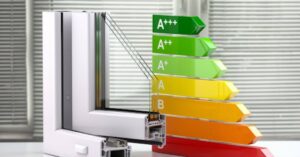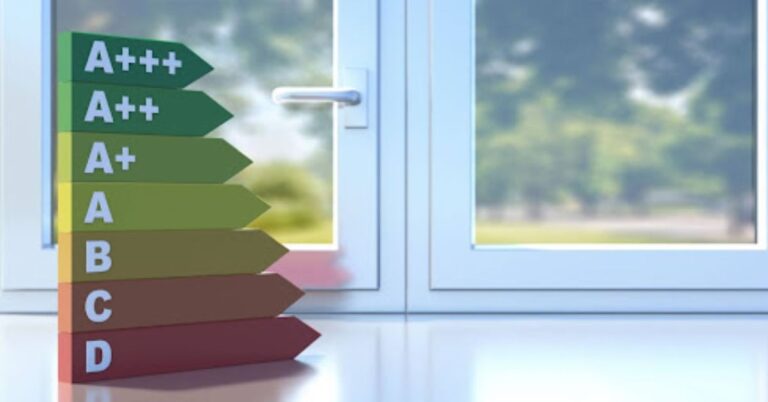Energy efficiency labels help homeowners make informed decisions when selecting windows by providing key performance metrics. These labels include ratings like U-Factor, Solar Heat Gain Coefficient (SHGC), and Visible Transmittance (VT), which indicate how well a window conserves energy. Understanding these metrics leads to better insulation, reduced utility bills, and improved home comfort.
Table of Contents
- Decoding the Key Metrics on Energy Efficiency Labels
- How to Use Energy Efficiency Labels for Your Climate
- Tips for Choosing the Best Energy-Efficient Windows
- Final Thoughts on Making an Informed Decision
Imagine this: It’s the middle of a Canadian winter, and you’re sitting by your living room window with a warm cup of tea. Despite the cozy atmosphere indoors, you notice a draft seeping through the glass. Sound familiar? This is where energy efficiency labels come into play. These small yet powerful stickers provide crucial insights into how well a window performs in terms of insulation, heat retention, and overall energy savings.
In this guide, we’ll break down everything you need to know about reading and interpreting energy efficiency labels so you can select the best windows for your home. Whether you’re renovating or building from scratch, understanding these labels will empower you to make smarter choices that align with your climate and budget. For example, if you’re exploring options for energy efficient windows Canada, knowing how to decode these labels can make all the difference.
By the end of this article, you’ll feel confident navigating the technical jargon and making decisions that enhance your home’s comfort while reducing energy costs. Let’s get started!
Decoding the Key Metrics on Energy Efficiency Labels
Energy efficiency labels can seem intimidating at first glance, but once you understand the key metrics, they become an invaluable tool for selecting the right windows. Let’s break down the most important terms you’ll encounter and what they mean for your home’s performance.
U-Factor – Measuring Heat Loss
The U-Factor measures how well a window prevents heat from escaping your home. It’s expressed as a number between 0.1 and 1.0, with lower values indicating better insulation. For Canadian winters, where keeping warmth inside is crucial, a low U-Factor (ideally below 0.30) is highly desirable.
Windows with a low U-Factor are particularly beneficial in colder regions like Northern Ontario or the Yukon, as they help maintain consistent indoor temperatures and reduce heating costs. When shopping for windows, prioritize this metric to make sure your home stays cozy during chilly months.
Solar Heat Gain Coefficient (SHGC) – Balancing Sunlight and Heat
The Solar Heat Gain Coefficient (SHGC) indicates how much solar radiation passes through a window and becomes heat inside your home. This value ranges from 0 to 1, with lower numbers meaning less heat gain.
In warmer climates or during summer months, a lower SHGC helps keep your home cool by blocking excess heat. However, in colder Canadian regions, a higher SHGC can be advantageous, allowing passive solar heating to naturally warm your space. Striking the right balance based on your location and seasonal needs is key to maximizing energy efficiency.
Visible Transmittance (VT) – Maximizing Natural Light
Visible Transmittance (VT) measures how much natural light a window allows into your home. Expressed as a number between 0 and 1, higher VT values mean more daylight penetration.
Maximizing natural light not only enhances the ambiance of your living spaces but also reduces the need for artificial lighting, contributing to energy savings. If you’re looking to brighten up darker areas of your home while maintaining energy efficiency, prioritize windows with a high VT rating alongside other favorable metrics.
Air Leakage (AL) – Ensuring a Tight Seal
Air Leakage (AL) measures how much air passes through gaps in the window assembly. A lower AL value signifies a tighter seal, which is critical for preventing drafts and maintaining consistent indoor temperatures.
In Canada’s windy and cold climate zones, windows with minimal air leakage are essential. They not only improve comfort but also reduce the strain on your heating system, leading to further energy savings. Look for windows with AL ratings below 0.3 for optimal performance.
How to Use Energy Efficiency Labels for Your Climate
Canada’s vast and varied climate zones mean that what works for one region might not be ideal for another. Understanding how to match energy efficiency labels to your local climate is essential for maximizing performance and savings. Let’s explore how to tailor your window selection based on where you live.
Cold Climates (e.g., Northern Ontario, Alberta, Yukon)
In colder regions, retaining heat is a top priority. Look for windows with:
- A low U-Factor (below 0.30) to minimize heat loss.
- A higher SHGC to take advantage of passive solar heating during the winter months.
- Minimal Air Leakage (AL) to prevent drafts in windy conditions.
For example, homes in Edmonton or Yellowknife benefit from windows that trap warmth while allowing sunlight to naturally heat indoor spaces. These features help reduce reliance on heating systems, lowering utility bills during long, harsh winters. If your home uses natural gas for heating, monitoring Columbia gas prices can further inform your decisions around insulation upgrades and long-term energy cost planning.
Moderate Climates (e.g., Southern Ontario, Quebec, British Columbia)
In areas with milder winters and warmer summers, balance is key. Prioritize windows with:
- A moderate U-Factor to provide year-round insulation without overemphasizing heat retention.
- A lower SHGC to block excess heat during summer while still allowing some solar gain in cooler months.
- High Visible Transmittance (VT) to maximize natural light and create bright, inviting spaces.
Homeowners in Vancouver or Toronto, for instance, should seek windows that perform well in both temperature extremes, securing comfort and efficiency throughout the year.
Humid Climates (e.g., Atlantic Provinces, Coastal Regions)
In humid areas like Nova Scotia or coastal British Columbia, moisture resistance and ventilation are critical. Consider windows with:
- Tight seals and low Air Leakage (AL) to prevent condensation and mold growth.
- Moderate SHGC values to manage heat gain without compromising airflow.
- Durable materials that withstand moisture exposure, such as vinyl or fiberglass frames.
Energy-efficient windows designed for these climates help regulate humidity levels indoors while maintaining a comfortable living environment.
Practical Tips for Matching Windows to Your Region
- Consult local building codes or energy efficiency programs specific to your province or territory. Many offer guidelines tailored to regional needs.
- Leverage tools like Natural Resources Canada’s ENERGY STAR® ratings, which categorize products based on climate zones.
- If unsure, consult a professional who can recommend windows optimized for your area’s unique weather patterns.
By aligning your window choices with your local climate, you’ll enjoy improved comfort, reduced energy costs, and a smaller environmental footprint—all thanks to smarter use of energy efficiency labels.
Tips for Choosing the Best Energy-Efficient Windows

Selecting the right energy-efficient windows involves more than just reading labels. To confirm you make the best decision for your home, consider these practical tips that go beyond the numbers and ratings.
1. Prioritize Frame Materials
The material of a window frame significantly impacts its performance and longevity. Here are some common options:
- Vinyl: Affordable, low-maintenance, and excellent insulation properties. Ideal for Canadian climates.
- Wood: Offers natural insulation but requires regular maintenance to prevent warping or rot.
- Fiberglass: Durable, stable, and highly energy-efficient, though slightly more expensive.
- Aluminum: Lightweight and sleek but less effective at preventing heat transfer unless paired with thermal breaks.
Choose a material that balances cost, durability, and energy efficiency based on your needs.
2. Opt for Double- or Triple-Pane Glazing
Glazing refers to the number of glass layers in a window. Double-pane windows are standard, but triple-pane options provide superior insulation—especially valuable in colder regions like Canada. Look for glazing filled with inert gases (e.g., argon or krypton) between panes, as these further enhance thermal performance.
3. Consider Low-Emissivity (Low-E) Coatings
Low-E coatings are microscopically thin layers applied to glass to reflect infrared light. This helps keep heat inside during winter and outside during summer, improving year-round comfort. Many energy-efficient windows come with Low-E coatings as a standard feature, so verify this when making your selection.
4. Don’t Overlook Installation Quality
Even the best windows won’t perform well if they’re improperly installed. Poor installation can lead to air leaks, drafts, and moisture infiltration, negating the benefits of energy-efficient features. Hire certified professionals who follow manufacturer guidelines and local building codes to guarantee proper fit and sealing.
5. Evaluate Cost vs. Long-Term Savings
While energy-efficient windows may have a higher upfront cost, they often pay for themselves through reduced utility bills and increased home value. Use tools like Natural Resources Canada’s energy savings calculator to estimate potential long-term savings based on your region and window choices.
6. Explore Rebates and Incentives
Many provinces and municipalities offer rebates or incentives for upgrading to energy-efficient windows. For example, programs under the Canada Greener Homes Grant provide financial support for qualifying products. Research available options to offset costs while contributing to sustainability goals.
Final Thoughts on Making an Informed Decision
Choosing the right windows for your home is a decision that goes beyond aesthetics—it’s about creating a space that’s comfortable, energy-efficient, and aligned with your lifestyle. By understanding energy efficiency labels and their key metrics, you’re now equipped to make choices that benefit both your household and the environment.

